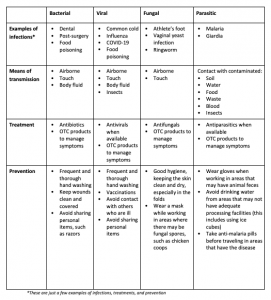Viral? Bacterial? Fungal? What Are The Different Types of Infections?
March 11, 2021
Infections are common. From ear infections and the flu to COVID-19, chances are we all have had at least one at some point. Viral, bacterial, fungal, and parasitic infections can all trigger sepsis. But what are the differences and why is it important to know which type you have?
Microorganisms or germs? What causes infections?
“Germs” is another word for microorganisms or microbes that cause disease. The three major types of germs we usually hear about are bacteria, viruses, and fungi. A fourth type called protozoa, is a type of parasite. There are other groups of parasites that can also cause infections.
The world around us is filled with microbes that live in water, air, and soil. For the most part, microbes aren’t harmful to humans and many are helpful. But if a microbe enters a part of the body where it shouldn’t be, it can cause illness.

Bacterial infections
Bacteria are single-cell organisms. They reproduce on their own and many can survive on surfaces for days or weeks. Bacteria can enter your body through any opening, natural or unnatural. This includes your mouth and nose, as well as cuts, scrapes, and even surgical incisions.
Most bacteria are good or harmless, as long as they stay where they are supposed to be. For example, your gut contains about 100 trillion bacteria. They help break down your food and drinks. They also help fight against “bad” bacteria.
As an example, if you develop a perforated bowel (hole in your gut), the bacteria that are so helpful in your gut can cause an infection in your abdomen – because that isn’t where they are supposed to be.
Treatments
Antibiotics are the go-to treatment for bacterial infections. This class of medications either kills the bacteria or stops them from reproducing and spreading. Not all bacterial infections need antibiotics and sometimes your body can fight them off on its own. This is why some doctors may take a wait-and-see stance sometimes.
Antibiotics are losing their effectiveness against some bacteria. Over the years, as antibiotics have been overused or misused, some types of bacteria have cleverly adapted by mutating, making it so the antibiotics can’t affect them. The result is antimicrobial resistance, or antibiotic resistance.
Antimicrobial resistance (AMR) is a real threat to humans. Before penicillin was discovered, people died of seemingly minor infections, as well as more serious ones. If the so-called superbugs, the ones resistant to treatment, continue to grow and spread, those minor illnesses may once again become much more serious.
You can learn more about bacterial infections here.
Viral infections
Many viral infections are common, from influenza to herpes, and can be easily spread. Unlike bacteria, viruses need living cells to keep them alive, allowing them to reproduce and spread. These are called the hosts. Another way of looking at it is viruses enter healthy cells and “hijack” them to grow and multiply.
Because viruses need those live cells for survival, they don’t do well on surfaces, outside of a living being. While some bacteria can live on a doorknob or tabletop for days or weeks, viruses usually can only survive for a few hours, although there are some that may live longer.
Viruses enter your body much like bacteria, through body openings, especially the nose and mouth (like COVID-19, colds, and the flu). They can also be spread through exchange of body fluids, like contaminated blood, or through sexual activity. Hepatitis C and HIV are examples of this type of spread.
Many serious viral illnesses can be prevented through vaccines. The most common examples are for childhood diseases like chickenpox, measles, and mumps. Some vaccines give life-long immunity, while others need boosters.
Treatment
Unlike bacterial infections, there are not a lot of cures for those caused by viruses. Antibiotics do not fight viruses, only bacteria.
Some antiviral medications treat illnesses like hepatitis C. There are also some treatments that can help manage infections like shingles or the flu, but you must take them early in the infection. They won’t cure it, but they can shorten the amount of time you are sick and reduce symptoms.
You can learn more about viral infections here.
Fungal infections
Fungal infections, like athlete’s foot, are often more annoying than serious. But some can cause severe illness, like fungal blastomycosis or histoplasmosis.
Inhaling fungal spores is one of the most common ways to develop an internal fungal infection. Fungal spores are often found in rotting vegetation or where animal feces are, like in chicken coops.
You can learn more about fungal infections here.
Parasitic infections
Finally, parasitic infections, such as malaria, are spread by parasites, either bugs or smaller microorganisms.
The most common parasitic infections, according to the Centers for Disease Control and Prevention, are Chagas disease, transmitted through the Chagas parasite; cysticercosis, caused by tapeworms; toxocariasis, caused by roundworms found in the feces of dogs and cats; toxoplasmosis, spread through contaminated food; and trichomoniasis, which is shared through sexual activity.
You can learn more about parasitic infections here.
No matter the type or cause of infection, all can trigger sepsis. Take all infections seriously and seek help if your infection worsens. If you suspect you may have sepsis, go to your closest emergency department or call 911. Be sure to mention you have an infection and you suspect you may have sepsis.






























